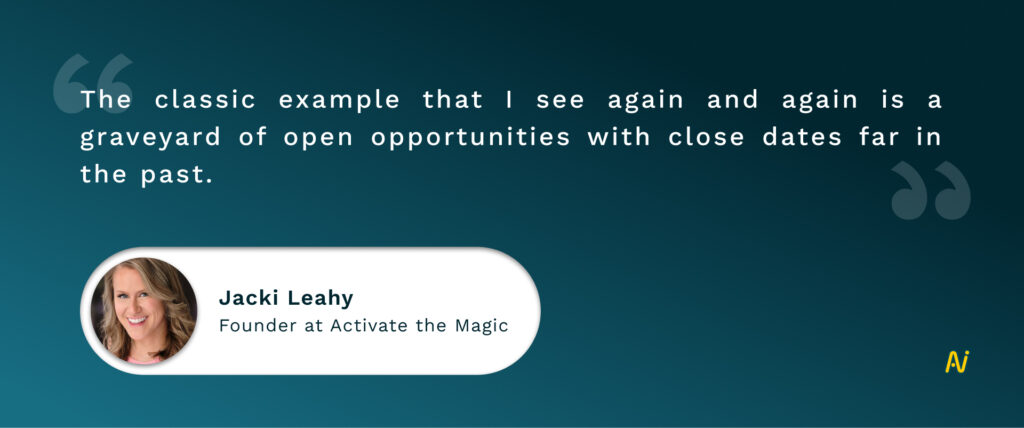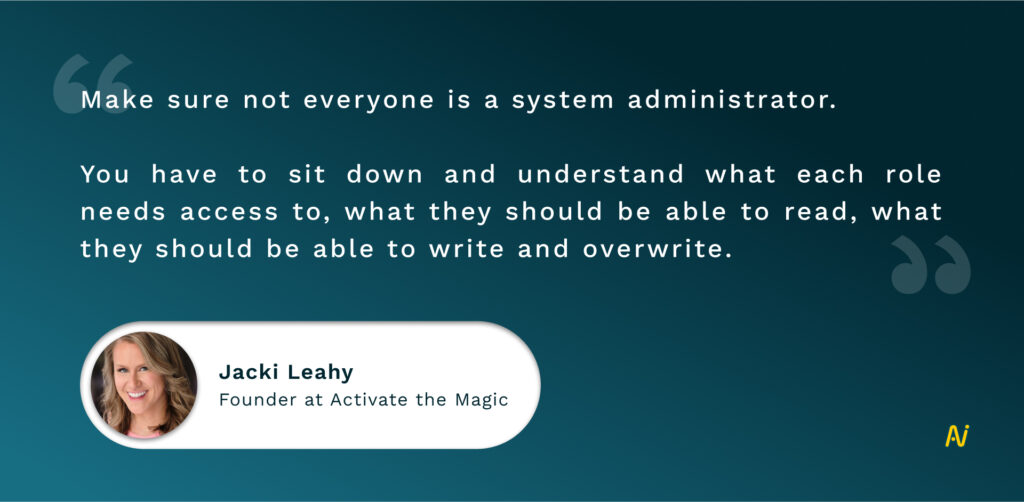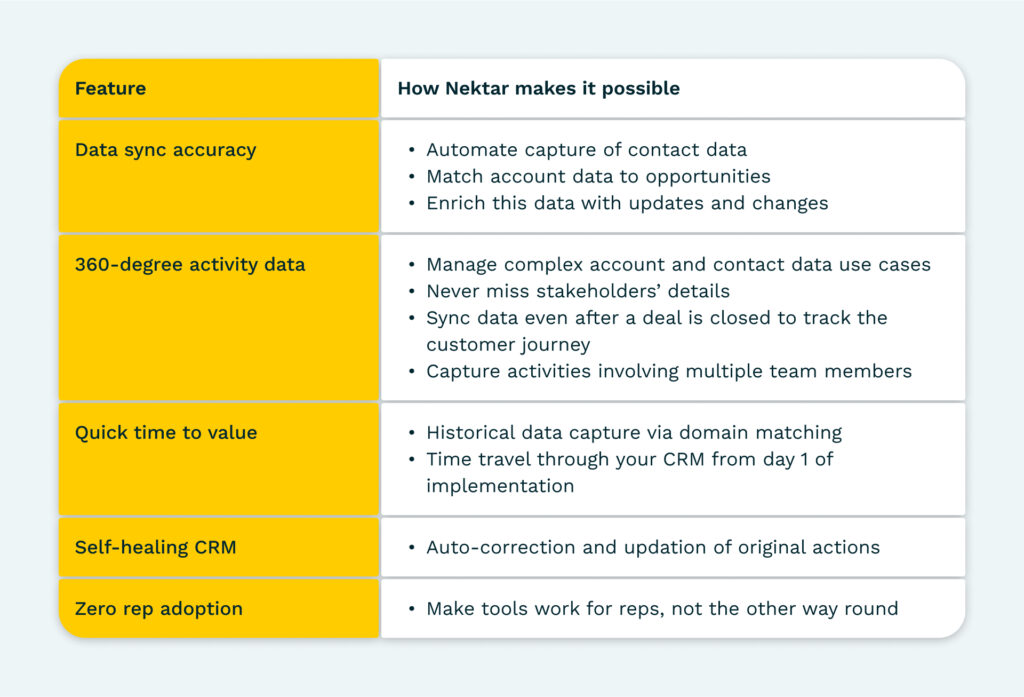The CRM system sits at the center of your tech stack. And often, it’s the first and most important investment you’ll make.
An excellent reason behind the CRM’s importance is that it significantly contributes to revenue-generating tasks like lead generation and customer retention.
But what happens when the key to driving ROI, aka clean CRM data, is of poor quality, incomplete, and inconsistent?
A revenue leak is what it is!
And it becomes worse when reps don’t adopt the CRM wholly.
A growing need for CRM systems coupled with dirty data and poor rep adoption—what can you do before it blows up into an unsolvable revenue problem?
We sought the answer to this question in our recent podcast interview with Jacki Leahy. Jacki is a Fractional RevOps Leader and Founder at Activate the Magic. She’s had a rather interesting career journey from a kindergarten teacher and Manhattan apartment broker to a RevOps leader.
Listen to the full conversation here:
Clean CRM Data is the Silver Bullet to Prevent Revenue Leaks
Data is what keeps your revenue engine running. This is no overstatement.
You need clean CRM data to perform the most basic functions, even if it’s just finding contacts. And you need the right contact data to reach the correct stakeholder or your champion. This data also powers successful marketing and sales campaigns for the buying committee.
You’re ruining the deal and incoming revenue if you get the data wrong.
Bad data poses serious repercussions and challenges to your business. Data inefficiencies may start small but gradually snowball into larger problems.
Here are 6 more ways that poor-quality data can derail your revenue.

1. Inaccurate Forecasting Throws You off Your Game
Revenue forecasts help build a solid ground so you’re not caught off guard during unpredictable business situations. They also drive data-backed decisions with analyses.
To sum it up, accurate information equals accurate forecasts.
You can see where we’re going with this. What happens when you don’t have clean CRM data pouring into forecasts?
Incorrect, incomplete, inconsistent, siloed, and duplicate data creates multiple challenges for revenue forecasting. To begin with, you can’t accurately predict your future performance. Nor can you detect the right patterns because poor-quality data skews your view.
It culminates in setting incorrect:
- Benchmarks
- Sales quotas
- Territories
- Resources allocation
Bad data slows down growth. You can’t take specific actions to track expenses, optimize cash flow, and set long-term goals on inaccurate forecasts.
And if that wasn’t enough, poor CRM data cleanup has another serious effect on funding. Incorrect forecasts lead to incorrect financial projections, becoming a critical mistake when reaching out to investors.
2. You’re Burdened With a Bloated Pipeline
Poor quality CRM data cleanup results in a bloated pipeline. All it takes is for one rep to say, “Hey, I may need that contact or deal data later!”
Remember that reps may have individual goals but also work in teams. If one rep decides to hoard data, their colleagues may follow suit. Over time, this data decays as stakeholders leave the buyer organization or deals fall through. None of these opportunities may be viable anymore.
At the end of it, your CRM becomes a dumping ground for old and outdated data.

But it’s not just reps to blame. Leaders, you’re on the radar, too.

Sales leaders who want every single data point from all the data sources care about too many things. It sounds weird. But really, focus on a handful of data points that you’ll be just immaculate and maniacal about.
Now imagine your pipeline holding on to this outdated data alongside tons of new data coming in every day. Until the time your CRM can take it no longer and bloats up.
Your reps end up chasing opportunities that don’t close instead of focusing on the “real” deals, i.e., the high-value ones.
3. Teams Don’t Collaborate
Only 32% of companies have a unified view of customer information in the CRM. The main conspirator? Siloed, duplicate, and incomplete data.
Your teams may be following different tools that don’t integrate with the CRM. It only compounds the problem further. For example, Marketing decides that prospects’ name, organization, and contact details are enough to qualify them as leads. In comparison, Sales notes the name, contact details, profession, organization, and location.
On top of that, both teams follow different naming conventions. In the marketing team’s tool, the lead may be listed as “David Blake,” but sales may list the same lead as “Blake, David.”
See what happened there?
You have duplicate data, and both data points follow a different data language.
Another problem is that your revenue teams are busy chasing the money. It may not give them enough time to update clean CRM data regularly. The information you have in your CRM becomes outdated or inaccurate.
What you get in return is:
- A mixed bag of insights on the ICP
- Ineffective marketing campaigns
- Inaccurate deal signals
- No information on what moves the lead to the next stage
- Reaching out to leads with the wrong information
- Friction-filled handoffs
- And more problems!
It gets very complicated, and you lose deals. 52% of sales leaders agree, saying misaligned sales and marketing teams cost them revenue.
4. Reps Aren’t Motivated to Adopt the CRM
CRM usage is the most significant indicator of sales productivity. Yet, 86% of reps are confused about which tool they should use for a task. And 80% of them lose time keeping track of multiple login credentials for various tools.
If that wasn’t enough, sales professionals actually spend less than one-third of their time selling. The rest is dedicated to administrative and non-selling tasks.
Naturally, reps aren’t happy. And if this continues to be a problem, buyers won’t be happy either.
It’s a huge problem, particularly when the buying cycle becomes more complex. Today’s buyer is a group of stakeholders who conduct their respective research and use multiple channels.
Reps can hardly keep up.
As a result, they feel that adopting a CRM is a waste of time. And when this CRM comes with multiple features and periodic updates or changes, they feel burdened to learn and relearn the system.
Worse, the data they enter manually may not even be accurate or relevant.
Bad data doesn’t give reliable, granular insights. If you don’t know what’s wrong, you can’t train and coach reps to improve their skills.
Inaccurate insights, improper coaching, poor communication between teams, time wasted on non-selling activities, and unhappy customers become a big pile of poor productivity for reps.
Reps must constantly put out fires and figure out where they went wrong instead of selling and making money.
5. Buying Experience Leaves a Sour Aftertaste for Customers
89% of buyers will more likely consider purchasing from a brand if the seller can change their way of thinking. That happens when buyers receive consultative selling over promotional sales.
Buyers are bombarded with the number of tools they need to look at and the amount of research they must do on each one. Consultative selling relieves the burden.
But to be consultative, sellers have to:
- Be more knowledgeable about their product and the industry
- Stay in touch with buyers for longer
- Personalize each interaction to maintain a competitive edge
None of this will be possible without clean and reliable data on the prospect or customer. When revenue teams don’t know what buyers want, they sell disjointed handoffs and incorrect communication.
37% of marketing leaders say disparate messages from across the company confuse buyers. At the same time, 50% of companies lose new sales because their CRM data is not clean.
Reps can’t multithread with buying committees if they have incomplete or inaccurate account data. Which means they can’t share customized content for each stakeholder. As Jacki points out, a solid relationship needs effort and understanding.

No solid relationship with the buyer = no deal.
It’s especially harmful in the current business environment, where retention is a key revenue goal.
6. You Don’t Get ROI From the CRM
Inaccurate forecasting, bloated pipelines, misalignment between teams, low sales productivity, and unsatisfactory buyer experience result in poor ROI from the CRM.

Your CRM becomes an example of “garbage in, garbage out.” If bad data goes into it, bad insights and decisions are the result.
Companies are already facing the consequences. 44% of CRM users note that their company loses over 10% of annual revenue owing to poor quality CRM data.
What are some other factors leading to a lack of CRM data cleanup?
- Manual entry
- No data cleaning at the source
- Non-compliant data
If you and your teams can’t leverage the CRM, you can’t make effective decisions, and your teams can’t cater to buyer needs.
As a result, the ROI on CRM investments has seen a 37% decline (down from $4.90 to $3.10 per dollar invested) over the last decade.
Solving the Clean CRM Data Quality Problem
Poor quality CRM data is a far-reaching problem impacting your entire organization.
But there is a solid solution.
By deploying RevOps, you can align teams on shared goals and common data language. It helps that RevOps maintains a maniacal focus on the customer journey. And so, it works to improve the customer experience for growing revenue.

Here are some of the best practices that RevOps follows for driving revenue with clean CRM data.
1. Understand That “Less Is More”

You don’t need to hoard all data for a future need. RevOps uses CRM data management instead.
CRM data management maintains a well-organized library of customer information. It structures CRM data cleanup to make data easily searchable and retrievable.
What happens next?
You find the right information in the right place and at the right time. Your reps can shorten the sales cycle when they get insights quicker and close deals faster.
A lean CRM makes for a refined ICP strategy and segmentation.

Using the amount of data you have correctly, without bloating the pipeline, gives you accurate and reliable information on contacts and accounts.
Regular CRM data cleanup is vital for functioning smoothly. For instance, schedule a cleanse every quarter and commit to it. Instead of multiple data points, focus on a handful of important points.
This practice ensures that your data stays immaculate and that you have all sources in place.
2. Let Data Governance Work Its Magic

RevOps pushes you to implement processes that prepare you for radical and consistent changes.
It starts by ensuring seamless data flow as per a common data language for your company. Next, RevOps maintains the quality, usability, and standardization of data.
It also establishes clear standards for your team to follow when entering clean CRM data. This encourages them to capture contact and account data in the correct format.
Data governance also stipulates naming conventions and validation rules to ensure data accuracy.
In addition to the above, RevOps provides role-based access controls. It reduces the risk of data breaches and non-compliance.

But it’s not just about the time data spends within your system. At the end of a data point’s lifecycle, RevOps safely and systematically disposes of data.
3. Prioritize for Repeatable Success

The first step is putting processes in place to maintain clean CRM data. Prioritizing high-quality data and committing to it is the next.
Change is intimidating, particularly if it affects your teams’ day-to-day activities. But you can encourage them to take concrete steps to solve the data problem by building a data-first culture.
This culture helps everyone across the organization to imbibe quality and ethical data practices.
Start from top to down. Leaders must be the first to prioritize CRM data cleanup.
To gain their trust and support, build compelling use cases and highlight the impact of dirty versus clean CRM data. You can also arrange a regular meeting cadence to align them with the rest of the teams.
Help reps to find data rule breakers and fix them.
A data-first culture also prioritizes growth by prioritizing the right deals. Reps don’t waste time and effort chasing impractical and low-intent opportunities.
With clean CRM data, your teams can:
- Prioritize problems that must be solved quickly
- Recognize improvement areas
- Adapt quickly to changing situations
- Follow repeatable processes to drive predictable revenue.
4. Empathize With the CRM’s End Users

As a leader, you can build a better CRM by empathizing and understanding the needs of its end users—reps.
Reps, themselves, want to do better. In 2023, 29% of sales reps aim to improve the selling process’s efficiency. Another 18% want to leverage clean CRM data to its maximum potential.
So, rather than basing your tool selection solely on features you feel are necessary, talk to your reps and get to know their requirements. Because when reps get what they need, they adopt the CRM more effectively and want to keep it clean.

Avoid the friction between man and machine. Automate as much as you can to make reps’ lives easier. Set up user processes before you implement the CRM. After implementation, drive process adherence among reps.
Your teams may also need continuous training to determine their roles and responsibilities for maintaining data quality.
Other than training, you can boost their data literacy skills, too. Show them multiple use cases of clean CRM data and empower them to leverage this.
This practice helps them understand:
- Why clean CRM data is crucial for growth
- How it aligns teams and supports them in decision-making
- What will be its impact on their performance
- How clean CRM data contributes to closing deals successfully
- How it provides deeper insights into customers for creating tailored approaches
5. Enrich Data With the Right Adjacent Tools

Even though the CRM is at the center of the tech stack, you may need adjacent tools for specific functions such as omnichannel communication. These tools, when chosen effectively, enrich your CRM data.
To build a seamless tech stack, select tools that are best of the breed and check if they integrate with your CRM. These tools should automate work for the reps, not burden them with more tasks.

For time-consuming tasks, check out voice-to-text and AI assistants. They can automatically transcribe meeting notes and push the insights into the CRM.
Next, conversational intelligence and other productivity tools keep reps on track with deals. These tools must also integrate smoothly with the CRM.
For instance, a goldmine of data is stuck in tools like calendars, virtual meeting platforms, notes, emails, and more. These should pour into the CRM without any manual effort for the teams.
You can also gather real-time insights and alerts for prompt action to move deals forward. Tools like Nektar Buzz can help.
It pushes the right insights to the right people at the right time. These alerts are sent directly to Slack or Teams so your sales teams can keep track in real-time without adopting another dashboard.
To know which CRM-adjacent tools are worth investing in, ask these questions before you move ahead.
Nektar Powers Predictable Revenue With Clean CRM Data
Cleaning and streamlining a huge chunk of data may seem like an uphill climb. That’s exactly why we’re here.
Nektar keeps your CRM data clean and actionable by automating data capture and enrichment.

Connect with our team to see Nektar in action.
PUBLISHED BY







